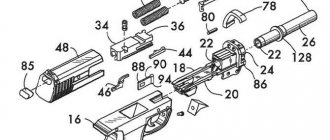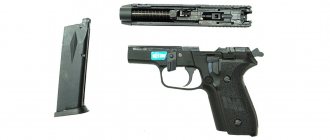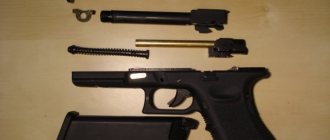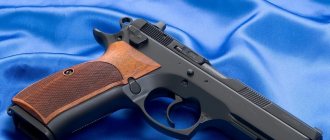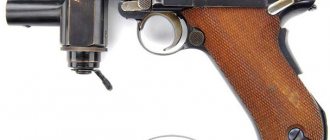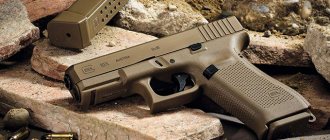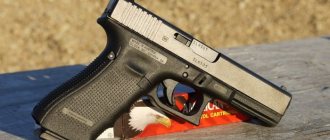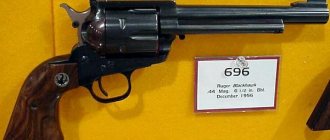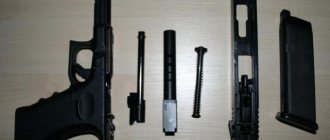The history of the creation of the TT pistol with a silencer
In the twenties of the last century, Red Army officers used revolvers and Mausers. Although they were used for many years, they gradually became obsolete. There was a need to switch to new models. The People's Commissariat of Defense announced a competition to create a new type of pistol.
Weapons designers actively responded to this initiative. 18 models were provided to participate in the competition. Among them were both Soviet designers and foreign ones. The reception group was led by M. Grushevsky. Extensive testing has been carried out. The Tokarev pistol was recognized as the best option, which received the official name “Tula Tokarev”.
The model was developed on the basis of the Browning pistol (model M1911). The trigger mechanism has been significantly redesigned. The new model lacked a safety lock and used a different type of cartridge.
Although the selection committee approved the adoption of the TT, it was not immediately accepted into service. The designer was asked to first modify the weapon in order to eliminate the detected deficiencies. To check the quality of the work done, the TT was sent for testing at the end of 1930.
The test results were positive. In February 1931, the Tula Arms Plant received an order for the production of the first batch of weapons, consisting of 1000 pistols. In 1931, the TT pistol was adopted for service.
Then general tests were carried out. In their course, despite the serious advantages of the new weapon, several shortcomings were identified. The problem was the lack of a safety lock, the relatively heavy weight of the pistol and the high risk of the magazine falling out during shooting. These problems, if they manifested themselves during real combat, could lead to tragedy.
F.V. Tokarev, designer who created the TT pistol
After receiving the test results, Tokarev carried out a thorough revision taking into account the comments made. He managed to significantly improve the operation of the mechanics, making it more reliable. It was possible to use a safety cocking mechanism. The magazine latch circuit has been changed and has become more reliable. The modified TT entered production in 1934.
Tokarev began work on a new series of improvements in 1939. The goal was to improve the ergonomics of the weapon. Attention was also paid to increasing the number of cartridges. These works began, but were soon curtailed due to the outbreak of war.
Another designer, G. Sevryugin, also took up modifications to the TT during the war. His version was ready in 1944. The main difference was the increase in the number of rounds to 16.
In 1947, another modernization of the Tula Tokarev pistol was carried out. Her goal was to reduce the cost of producing these weapons. At the same time, the technological process for manufacturing CTs was improved.
The Tula Tokarev pistol became one of the best during the Great Patriotic War. However, its production was discontinued in 1952. It is believed that copies produced between 1948 and 1952 were of the highest quality. Until the early fifties, the TT was the most popular pistol in the Soviet Army and law enforcement agencies.
This weapon was replaced by the Makarov pistol. One of the reasons for abandoning the TT is considered to be the high power of the cartridge. The muzzle energy of the bullet flying out of the barrel was 500 J, which was higher compared to analogues. Another reason was insufficient wearing safety. The TT was removed from service in the army in the late sixties. The use of this pistol was completely discontinued in the 80s.
In the post-war period, a significant number of TT pistols fell into the hands of private individuals. The spread of these weapons was facilitated by the high prevalence of 7.62x25 cartridges. These pistols have remained popular today.
Although TTs have been withdrawn from service, they are produced under appropriate license in many countries. Suppressors for this pistol first went on sale in 1990. They are used for combat, airsoft, flash-noise and other types of weapons.
During its existence, several modifications of the pistol were made. Combat TTs were produced in the following versions:
- In 1931, the first production model began to be produced.
- A new version entered production in 1934. The automation has been improved.
- In 1947, the final version of the Tula Tokarev pistol appeared. The changes were aimed at optimizing the production process.
Sports modifications of the TT were produced:
- Model P-3 is designed to fire the 5.6 mm cartridge
- The pistol was made in Poland by Tokarev Sportowy and used the .22 LR cartridge for shooting.
- Model S-TT.
There is a traumatic weapon based on the Tula Tokarev pistol:
- TT-T is produced by the Degtyarev Plant. Uses 10x28 T cartridge.
- Produced by VPO-509 “Leader-M” in Vyatskie Polyany. It fires 11.43x32 T cartridges.
- MP-81 is produced by the Izhevsk plant. Can fire 9mm rounds.
The following CT signal models exist:
- The TT-S is designed to fire Jewelo primers or KV21 cartridges.
- MA-TT-CX is a watered-down version of the combat pistol.
Nowadays, many countries produce combat models of TTs under license. Among them there are both exact copies of the original weapons and modifications made on its basis. The most famous among them are the following:
- China produces the 213B model, which is designed to fire 9 mm cartridges.
- Tokarev 48M is produced in Bulgaria. It is designed to fire 7.62 mm cartridges.
- North Korea produces the M68, which has a caliber of 7.62.
- PW wz.33 7.62 mm is produced in Poland.
- The Yugoslav Zastava model is designed to fire 9 mm or .40 S&w cartridges.
A pneumatic version of the TT is available. It largely retains the appearance of the original, but shoots 4.6mm pellets. These weapons are produced by a large number of companies.
Air gun based on TT
There are special models for airsoft. Externally, they are complete copies of a combat pistol. They also simulate its recoil.
Airsoft pistol Galaxy G.33A (6 mm, TT, silencer)
The promotion is valid for order amounts over RUB 6,500. More details in the delivery section!
- Pickup: Moscow, Oktyabrskoye Pole metro station, st. Marshala Biryuzova, 30, from 9-00 to 21-00. St. Petersburg, metro Technological Institute-1, st. Angular Lane, 3A, from 9-00 to 21-00.
- By courier: We deliver most orders on the day of order ! Delivery cost within the Moscow Ring Road (KAD) from 0 rub. Delivery cost outside the Moscow Ring Road (KAD) from 400 rubles.
- Russian Post: Delivery cost from 0 rub. Delivery exclusively by national mail (not Air). It is possible to pay upon receipt - Cash on delivery.
- Transport company:
Energy, PEC, Business lines, etc. - Boxberry: Courier service. Delivery cost from 0 rub. It is possible to pay upon receipt - Cash on delivery.
- SDEK: Courier service. Delivery cost from 350 rub.
- DPD: Courier service. Delivery cost from 350 rub.
The promotion is valid for order amounts over RUB 6,500. More details in the payment section!
- Pickup: Free. (In Moscow and St. Petersburg)
- By courier: Delivery cost from 0 rub. (Moscow, Moscow Region, St. Petersburg and Leningrad Region)
- Russian Post: Cash on delivery (All Russia).
- Boxberry : Courier service. Payment upon receipt (All Russia)
- SDEK : Courier service. Cash on delivery (All Russia)
- Bank card Visa/MasterCard, etc.
- By bank receipt
- Yandex money
- QIWI
- Payment to bank account
- Payment in cash upon receipt!
- Delivery in Moscow and St. Petersburg on the day of order!
- Free delivery throughout Russia!*
- 12 month warranty on all products!
- Exchange/return goods within 14 days!
- We work seven days a week from 9.00 to 21.00!
- All products undergo pre-sale inspection!
Characteristics of a TT pistol with a silencer
| Characteristic | Parameter |
| Caliber | 7.62 mm |
| Weight of weapon including magazine | 940 g |
| Weapon weight without magazine | 845 g |
| Ammunition type | 7.62x25 |
| Magazine capacity | 8 |
| Shot speed | 420 m/s |
| Rate of fire | 8 shots in 15 seconds |
| Barrel length | 119 mm |
| Maximum sighting range | 50 m |
Here are the characteristics for the original TT. Also produced were: combat modifications (under license), traumatic, sports, pneumatic and special airsoft weapon models.
Characteristics of the Galaxy G.33A airsoft pistol (6 mm, TT, silencer)
| Manufacturer | Galaxy |
| Combat prototype | TT, Tula Tokarev (USSR) |
| View | Airsoft pistol |
| Type | Spring (spring) |
| Caliber | 6.0 mm |
| Speed | 60-69 m/s |
| Type of ammunition | Plastic balls 6 mm |
| Barrel type | Smooth |
| Number of charges | 11 pcs |
| Shooting mode | Single |
| Energy source | Manual cocking spring |
| Blowback | No |
| Fuse | No |
| Shutter material | Metal |
| Frame material | Plastic |
| Color | Black |
| Size | Length - 205 mm |
| Weight | 490 grams |
| A country | Hong Kong |
| Equipment | Pistol, silencer simulator, packaging, brief documentation, copy of certificate (upon buyer's request), set of balls |
Airsoft pistol Galaxy G.33A (6 mm, TT, silencer) buy in the Popadiv10 online store. Airsoft pistol Galaxy G.33A (6 mm, TT, silencer) at a low price of RUB 1,702. You can pay for your order by mail upon receipt in any part of the Russian Federation. Before placing an order, be sure to check the price and contents of the product by phone (during business hours) or by e-mail and feedback system (at any time convenient for you).
Source of the article: https://popadiv10.ru/straykbolny-pistolet-galaxy-g33a-tt-s-glushitelem/
Structure of the TT pistol
One of the important features of weapons is simplicity. The body is made of steel, the parts are relatively large in size. The operation of the trigger mechanism uses a short stroke of the free bolt under the influence of the energy of exhaust powder gases.
When a shot is fired, the bolt moves back. In this case, the cartridge case is ejected and the trigger is retracted. Under the action of the return spring, the bolt returns to its place and sends a new cartridge into the chamber. Next, the barrel is locked.
The weapon uses a flat magazine that holds 8 rounds. There is a window on the side through which you can control the number of cartridges in the clip. When the entire magazine is expended, the slide stop is activated. It will lock the shutter in the rearmost position. Once a new magazine is inserted, the bolt will automatically return to its operating position.
An extended barrel and a powerful cartridge contribute to higher accuracy of the weapon. The rear sight and front sight, which are located in the upper part of the pistol, are used as sighting devices.
The handle pins are made of bakelite. During the Great Patriotic War they were made of wood.
Wearing safety is ensured in a special way. Since the TT does not have a safety lock, the trigger safety position is used to prevent spontaneous firing.
This mechanism works as follows. To remove the pistol from the safety cock, simply cock the hammer. To install, you need to complete the following steps. To do this, you need to pull the trigger, holding it while pressing the trigger. Then the trigger is pulled back a little. As a result, the trigger and shutter will be locked.
In this case, the trigger will not touch the firing pin. This method of fixation guarantees the impossibility of an accidental shot. The pistol was not allowed to be carried with the trigger pulled, since in this case the risk of accidental firing cannot be ruled out.
Airsoft pistol G.33A (TT)
A modification of the Galaxy G.33 model with the letter A is a spring model designed for airsoft. The main difference of the G 33 A is the presence of a muffler simulator in the kit. In addition to its aesthetic role, it serves as a barrel extension. With an extended barrel, a projectile fired from a pistol flies more accurately and hits a target at a distance of up to 20 meters.
Otherwise, this is, as before, a high-quality replica of the pride of Soviet gunsmiths, the TT pistol. It is no different in size and appearance from its combat ancestor. Even the fuse present in the design is located and looks the same as the fuse on a military weapon.
In terms of power, the Galaxy G 33 shows quite decent results and at the same time cannot cause injury if it hits a person. Of course, this is due not only to the power of 0.5 J, but also to the need to observe certain safety precautions. So, to avoid ricochet and eye injury, use special safety glasses. They can also be purchased in our store.
As for the rate of fire, it is not as high as on pistols with other operating principles. However, the advantages in quality of performance and cost significantly outweigh this small drawback.
In order to fire a shot from the Galaxy G.33A, you need to pull the bolt back, thereby compressing the working spring. The bolt will then return to its place on its own, which is very reminiscent of the action of a real weapon. This process will need to be repeated each time before firing.
This model, like all airsoft weapons, shoots with plastic balls with a diameter of 6 mm . The muzzle energy mentioned above sends them flying towards the target at a speed of 69 m/s.
In total, 11 balls fit into the magazine of this specimen.
Source of the article: https://cccp-gun.ru/shop/1160/desc/strajkbolnyj-pistolet-galaxy-g-33a-tt-s-glushitelem
Advantages and disadvantages of the model
Advantages and disadvantages
The simplicity of the design made it relatively cheap to produce and easy to maintain.
Common cartridges are used.
A powerful cartridge with great penetrating force is used.
Relatively high firing range for a weapon of this class. It is 50 meters.
High accuracy of fire.
Unreliable magazine fixation. Its latch is located where the thumb is when shooting. It is very sensitive and easy to trigger.
The pistol is considered to have poor ergonomics.
Low stopping effect.
No manual safety.
This weapon was actively used during the Great Patriotic War and continues to be used now. It has earned fame due to the following advantages:
- Thanks to its thoughtful design, the pistol maintains a high rate of fire.
- Simplicity and high reliability of the design.
- High destructive power of the ammunition used.
- Easy to use this weapon.
- The maximum effective firing range is high for this class of weapon.
- Easy to assemble and disassemble the gun.
These qualities have made the Tula Tokarev pistol widely popular all over the world. However, it must be borne in mind that this model has its drawbacks:
- The pistol does not have a safety lock, which significantly reduces the safety of carrying.
- High risk of the magazine accidentally falling out.
- Rapid barrel wear. Manufacturers sometimes provided a spare one in the kit.
- The bullet has weak stopping properties.
Despite the presence of shortcomings, the TT has always been very popular.
Review of the Cooled Pistol TT-SO TOZ 1945 SO-TT/9im TOZ
TT-SO No. EE5957 1945 SO-TT/9im (Izhevsk) 1945. Military. The pistol is in very good condition. The shutter has a large notch. Standard deactivation "TOZ" 2022. Complete with post-war Marxist holster. Additional photos upon request. Price — 89900 rub.
Ammunition for pistol
The 7.62x25 mm cartridge is widely used. It is designed based on the 7.63x25mm Mauser. Externally it differs from the prototype with a slightly protruding edge and an enlarged groove.
This cartridge was actually the first to be adopted into service in the Soviet Union. It was also used in submachine guns. When a competition was announced to create a new pistol, it was believed that it should use the Mauser cartridge. A large number of which were purchased for the army.
As a result of research work, it was decided to use 7.62x25 mm in the future. This decision was made in 1930. During testing, this cartridge showed higher accuracy compared to the German prototype. It used a primer that was used in Nagant cartridges. Its diameter was 5 mm versus 4.5 mm for Mauser cartridges.
The increase in the groove was made in order to make the operation of the cartridge ejector more reliable. The cartridges were made of latin or steel. When using a variant with an enhanced powder charge when firing from a TT, the bullet energy reaches 610 J, and the speed when leaving the barrel is 480 m/s.
Disassembling the pistol
Disassembly of the pistol may be incomplete or complete. The first option is most often used. Disassembly may be necessary to clean, lubricate, or repair the weapon. To carry it out, you need to prepare a clean place. The parts are laid out in the order they were removed. It is not recommended to stack them on top of each other to avoid the risk of accidental damage. In case of incomplete disassembly, operations are performed in the following sequence:
- You need to remove the magazine.
- Check that the chamber is empty.
- Press the bushing to remove its engagement with the tip of the return spring.
- Turn the sleeve, then take it out along with the spring and tip.
- Slide the bolt stop spring, releasing the rod. Then they take her out.
- Using a forward movement, remove the bolt and barrel.
- The barrel is separated from the bolt by removing it from the muzzle area.
- The trigger mechanism is removed from the frame.
This completes the partial disassembly. Reassembly is done in reverse order.
The history of the TT pistol can begin at the end of the last century, when Hugo Borchardt used a cartridge with smokeless powder for his 7.65 mm self-loading pistol, which became one of the first ammunition for self-loading pistols. A powerful cartridge in combination with an attached butt made it possible to conduct aimed fire from the pistol at a distance of up to two hundred meters. A few years later, the Mauser brothers used an improved Borchardt cartridge in the Mauser K-96 pistol. The new 7.63x25 mm (Mauser) cartridge was ideal for the pistol-carbine concept they adopted. Firing accuracy at distances prohibitive for conventional pistols was excellent, although the presence of divisions on the adjustable sight, implying the ability to fire at a distance of five hundred to thousand meters, was difficult to take seriously. When the Mauser pistol appeared in the United States at the beginning of the 20th century, the cartridge was assigned the designation .30 Mauser, which was more understandable to American shooters. For forty years, until 1935, when the .357 Magnum revolver cartridge was developed in the United States, the Mauser cartridge was one of the most powerful of all revolver and pistol ammunition. And it was this cartridge that Tokarev chose for his pistol. In order to unify technological tools and equipment, the 7.63 mm Mauser cartridge was matched with the Russian 7.62 mm caliber. The first Tokarev pistol was designed for this caliber. The pistol had a blowback bolt and a hammer-type firing mechanism. The fuse was located on the right side of the bolt. The pistol allowed single and automatic fire. The cartridges were fed from a box magazine with a capacity of 22 cartridges, which were arranged in a checkerboard pattern, or from a clip that was inserted into the grooves of the bolt. The sights were designed for a firing range of up to seven hundred meters. During testing, the pistol showed high ballistic characteristics. Having won in all respects over other models, it was clearly inferior to them in weight and dimensions. True, the experience gained was not in vain when developing the next model, which became the future TT; the designer tried to ensure that all parameters complied with accepted standards. The TT pistol was created by a design team headed by F.V. Tokarev. Given the importance of the work, this group was included in the design bureau created in 1927 at the Tula Arms Plant, which was initially involved in the development of new small arms and cannon weapons for the rapidly developing Soviet aviation. Nine years later, the bureau was renamed the Central Design Bureau (TsKB), later TsKB-14, and then the Instrument Design Bureau. The first official tests of the TT pistol took place in June 1930. The commission, chaired by V.F. Grushevsky, conducted field tests of the Tokarev pistol along with Korovin, Prilutsky pistols and the best foreign examples of the Walter, Browning and Parabellum systems. The commission's conclusions were clear: the TT pistol is the most acceptable and suitable for adoption, provided that the identified shortcomings are eliminated? The commission's claims were quite serious - to increase accuracy, improve safety, and others. It sometimes takes years to eliminate such shortcomings; Tokarev managed it in a few months. In December 1930, tests of the TT pistol and other new models took place again at the Shot school training ground. In the report of the chairman of the commission K.P. Uborevich, Fr. Success for the TT pistol came in February 1931, when the Revolutionary Military Council of the USSR decided to order the first batch of pistols in the amount of a thousand pieces for comprehensive testing among the troops. The pistol was given the official name 7.62 mm self-loading pistol model 1930. The situation repeated forty years ago, when Nicholas II deprived the Mosin rifle of its name by decree, ordering it to be called the 7.62-mm rifle mod. 1891. Justice triumphed later, when the pistol gained worldwide fame as the TT pistol (Tulsky, Tokarev). For several more years, the pistol underwent constant modernization in order to reduce the cost and simplify its production. Mass production began in 1933 at the Tula Arms Plant and reached more than 100 thousand units per year by the beginning of the Great Patriotic War. However, the fate of the TT was not cloudless. For many years it was unable to completely supplant the 1895 revolver. Its production either fell or increased again. It was only during the fighting on the fronts of the Great Patriotic War that the TT pistol received final recognition. At the beginning of the war, the advance of fascist troops to Moscow also endangered Tula, the forge of Russian weapons. The USSR government decided to transfer defense production to the east of the country. Thus, the production of TT pistols and Nagan revolvers was entrusted to the Izhevsk Mechanical Plant. However, even in such difficult conditions, Tula gunsmiths were able, using the equipment and tools remaining after the evacuation and repairing old machines, to repair pistols coming from the front and assemble new ones from the remaining stock. In the last two months of 1941, workers at the plant's repair shops sent more than five hundred TT pistols to the front lines. As soon as the German troops were thrown back from Moscow, the restoration of the plant began, which in a matter of months, having managed to restore production and energy, began to work at full capacity again, but never began to continue producing TT. After the end of the war, mass production of Tokarev pistols was launched only at the Izhevsk Mechanical Plant. Until the early fifties, when the Makarov pistol replaced the TT, these factories produced more than a million Tokarevs.
Development was also constantly underway to improve the TT pistol; in 1942, prototypes were made with high-capacity magazines for 15 rounds, but these pistols did not go into mass production; about 1000 copies were produced. The difference from a regular TT was in the magazine capacity, in the shape of the handle, and the principle of fixing the magazine was also changed.
PISTOL DESIGN
During the Great Patriotic War, the TT pistol was the main personal weapon of officers and generals of the Soviet Army and was intended for close combat at distances of up to fifty meters. The pistol is a self-loading short-barreled weapon in which the feeding and chambering of a cartridge into the chamber, locking and unlocking of the barrel, removal from the chamber and ejection of the spent cartridge case are carried out automatically. The automatic operation is based on the well-known Browning principle, in which the inertial recoil mass is formed by a bolt engaged with the barrel during a short stroke. The pistol is fired in single shots. The cartridges are fed from a flat box magazine located in the pistol grip. Among domestic and foreign pistols, the TT is distinguished by its high penetration ability and destructive power. These qualities are ensured by a powerful cartridge and a fairly long barrel length.
A-shutter-casing, II-barrel, FF-earring, G-striker, J-trigger box, H-trigger, I-mainspring, M-disconnector, V-trigger rod, S-trigger spring, UQ -handle covers, R-magazine, W-magazine latch, Z-frame, CC-return spring, JJ-guide sleeve The pistol consists of the following parts and mechanisms: The frame (Z) is used to connect all parts of the pistol. It consists of the frame itself and the firing mechanism block. On the handle, the left and right cheeks are attached to the strips with special fastening parts. A magazine latch is attached between the handle and the trigger, which at the same time serves as a rearward travel limiter for the trigger. The moving part of the pistol consists of a barrel with an earring, a bolt with a guide sleeve and a return spring (CC). The barrel (II) has a boss, in the cutout of which the barrel earring is placed on the axis. When assembled, the bolt stop rod is inserted into the lower hole of the earring. In the middle part of the barrel there are two half-lance cutouts for connection with the bolt protrusions when locking the barrel bore. When rolling back, the barrel rests against the bottom of the frame groove, and the guide sleeve with the bolt begins to slide along it. The bolt (A) is a block mechanism for attaching a guide bushing with holes for the barrel (top) and for the tip of the return spring (bottom). The bolt contains a firing pin and an ejector, which are secured with pins. The shutter moves on the frame along its longitudinal projections. Rearward movement of the bolt is limited by the base of the recoil spring guide rod. When rolling forward, the forward movement of the bolt and barrel is limited by the stop of the earring against the wall of the barrel boss cutout, and the blow is perceived by the bolt stop rod. The trigger mechanism consists of a trigger, a hammer with a spring, a sear with a spring, an axis and a disconnector. The disconnector additionally acts as a safety device against shots when the bolt is not completely locked, since it disconnects the clutch of the trigger rod with the sear if the bolt is in an incorrect position. Sights are designed for targeted shooting and consist of a front sight and rear sight. The rear sight is mounted in the bolt groove by punching. The pistol is zeroed at twenty-five meters. The magazine (R) holds eight rounds. Consists of a box, a feeder with a spring, a lid and an insert. The magazine has holes to indicate the number of rounds. It is inserted into the handle and fixed there with a latch that fits into a cutout on its right wall. The shutter stop holds the shutter in the rear position and is located on the left side of the frame. The rod passes through the lower hole of the barrel earring and is fixed on the opposite side with a fork-shaped spring. After the cartridges are used up, the feeder, with its hook, presses on the bolt stop tooth, which, turning, stops the bolt in the rear position. To return the bolt forward, you must either press the ridge of the bolt stop blade, or separate the magazine and pull the bolt back and release.
INTERACTION OF PARTS AND MECHANISMS WHEN SHOOTING In the initial position, the loaded magazine is inserted into the pistol handle, the trigger is on the safety cock. To fire the first shot, the hammer is cocked, the bolt is retracted to the rearmost position and abruptly released. Under the action of the return spring, the bolt moves forward, captures and advances the cartridge into the chamber, engages with the barrel and locks the barrel in the forward extreme position. The pistol is ready for the first shot. When you press the trigger, the trigger rod presses on the protrusion of the sear and turns it, causing disengagement from the trigger, which, under the action of the mainspring, turns and hits the firing pin - a shot occurs. The resulting powder gases, acting on the bottom of the cartridge case, cause the bolt to roll back. The barrel, held by the protrusions in the grooves, moves along with the bolt, gradually lowering down under the action of the earring. By the time the pressure of the powder gases drops to a safe value, the movable coupled bolt-barrel system will have passed about three millimeters, and the barrel will disengage with the bolt. Having walked a little further forward and dropped down, he hits the frame of the pistol and stops. The bolt, together with the sleeve held by the ejector in the front cup, continues to move backward. When it encounters a reflector, the sleeve is ejected. The hammer is cocked and goes behind the combat cock. At the same time, the shutter, with its bevel, recesses the disconnector, thereby disengaging the sear and the trigger rod. The sear, turning freely, goes behind the combat cock and holds the hammer in the cocked position. The next shot is possible only after pressing the trigger again. The shot will occur only after the barrel is completely locked, when the disconnector can rise into the corresponding recess of the bolt and allow the trigger rod to move in front of the sear.
Operation of the TT pistol mechanisms at the moment of firing When the bolt moves forward, it captures the upper cartridge from the magazine and sends it into the chamber. To direct the cartridge into the chamber, use the bevels of the front fork of the trigger block and the bevel on the breech end of the barrel bore. When the bolt approaches the barrel, they begin to move together and rotate the breech until the protrusions are completely engaged. When the movable bolt-barrel system is in the extreme forward position, the disconnector rises into the bolt recess, allowing the trigger rod to engage the sear. The pistol is ready for the next shot. The pistol does not have a hand-operated safety or decocking lever. To prevent accidental firing, the trigger has a safety cock. The trigger is placed in the safety position by turning it a few degrees. In this case, the sear tooth will jump behind the safety cock of the trigger. In this state, it is impossible to press the shutter and cock the shutter. When setting the hammer to the safety cock from the cocked position, it is necessary to hold the trigger, press the trigger and smoothly return the hammer to the uncocked position and, releasing the hammer, smoothly cock it again until it is set to the safety cock.
DISASSEMBLY AND ASSEMBLY OF THE PISTOL
Self-loading pistols are products of fine mechanics and technology. To ensure reliable operation, you need to know their structure and be able to recognize the first signs of an impending technical illness. An important and mandatory step in this direction is to master the skills of disassembling and assembling weapons. Disassembly of the pistol is divided into incomplete (partial) and complete. Partial disassembly is carried out for the purpose of maintenance of the gun, its inspection and lubrication. Complete disassembly is required much less frequently, but it is mandatory in cases where the pistol has been in special conditions - it fell into water, fell into the mud, or was in various environments of increased aggressiveness for a long time. The first necessary rule for performing this operation is to choose a clean and comfortable place. A smooth table, a wide bench, and even bedding are best suited for this. During complete disassembly, it is necessary to maintain accuracy and order: place parts and mechanisms in the order of disassembly, handle them carefully, and avoid sharp impacts. When assembling, pay attention to the numbering of parts - confusion with parts of other pistols, even of the same system, is unacceptable.
INCOMPLETE DISASSEMBLY
1. Remove the magazine. 2. Use the end of the magazine cover to move the bolt stop spring back and, holding the bolt, press on the freed end of the bolt stop rod and remove it. 3. While supporting the return spring, remove the bolt and barrel from the frame. 4. Turn the bolt with the return spring up, press the head of the guide rod to remove it from the bolt and separate it along with the rod and tip. 5. Separate the bolt guide sleeve by rotating it 180 degrees relative to the bolt. 6. Disconnect the barrel from the bolt and remove it by the muzzle. 7. Remove the trigger block, holding the frame by the handle. Partial disassembly of the pistol is completed. The pistol is reassembled in the reverse order. To connect the barrel to the bolt, the barrel must be inserted into the bolt, tilting the earring back. When installing the bolt on the frame, the trigger block should be recessed so that it does not interfere with the free movement of the bolt. To attach the bolt stop, move the bolt back a little so that the hole in the barrel mount aligns with the hole in the frame.
COMPLETE DISASSEMBLY
Before complete disassembly, it is necessary to partially disassemble the gun. Further disassembly is carried out as follows: Disassemble the trigger block: 1. Pull the trigger back, knock out the sear axis and remove the sear and disconnector. 2. Using the disconnector rod, push out the trigger axis and separate it along with the spring. It is necessary to hold the spring and ensure that it does not fly out when the load is released. To disassemble the frame: 1. Using the long feather of the USM block, turn the tail of the fastening bar of the left cheek and, pressing on it from the inside, separate it. Repeat the same with the right cheek. 2. Push the cover catch upward and, pressing from the inside, separate the release spring and latch from the cover. 3. By pressing the split head of the magazine latch pin, push it out of the base and frame. Separate the base from the frame and remove the magazine latch spring from the pin. 4. Remove the trigger from the frame socket, moving it forward. To disassemble the return spring: 1. Separate the guide rod from the return spring. 2. Separate the tip from the return spring by turning it in different directions. To disassemble the bolt: 1. Knock out the firing pin and remove the firing pin with the spring. 2. Repeat a similar operation with the ejector. To disassemble the magazine: 1. Press the pointed end of a match or pin into the magazine cover delay, move it forward and, holding the delay with the spring, remove the cover. 2. Remove the spring with the feeder. Complete disassembly of the pistol is completed. Reassemble the pistol after complete disassembly in the reverse order. When assembling the magazine, after inserting the feed spring, a delay is applied to it with the bent end outward and forward. By pressing it, the delay should be recessed flush with the bottom edge of the magazine and, holding it in this position, slide the lid onto the magazine. After assembly, it is necessary to check the functionality of the gun.
SOVIET POST-WAR TT
To this day, the post-war TT pistol is in service with military personnel units and irregular formations in some CIS countries. The service life of these pistols, produced in the forties and fifties, has long been exhausted, so they are extremely unreliable. Common defect? misalignment of the cartridge and its sticking. Previously, standard army pistols were used for sports shooting, since, according to the conditions of the competition, design changes and modifications were not allowed. On the basis of the TT pistol, designer Sevryugin created two models of sports pistols in the fifties: R-3 and R-4.
The R-3 pistol had a blowback action and fired 5.6 mm cartridges.
For the P-4 model, an attached holster was developed - a buttstock, which was attached to the back of the handle. In most cases, the shooters “refined” the trigger force allowed by the competition rules, equal to one and a half kilograms. The use of a stock when firing from the R-4 allows for fairly high fire efficiency at distances significantly exceeding the usual 25-50 meters provided for personal weapons. TT has become widespread in foreign countries. In the early nineties, this pistol returned home again: thousands of TTs, mostly made in China, poured into the Russian arms market like an avalanche.
TT PISTOL IN THE FORM OF A MODEL. MODIFICATIONS AND DIFFERENCES. (article by IvanT) https://forum.guns.ru/forummessage/85/188779.html
The history of the TT pistol, as we know, speaks of two main modifications. This does not include its sports clones, prototypes and low-volume samples.
These are a 7.62mm Tokarev pistol of the 1930 model and a 7.62mm Tokarev pistol of the 1933 model. In addition, since 1947, the pistol began to be mass-produced with a fine notch on the bolt housing, although similar pistols were produced in 1946, along with pistols with a large notch. This can hardly be called some kind of new modification, but outwardly it differs from previous production pistols. In this topic, I decided to illustrate the changes in the Tokarev pistol using the example of the MMG Tokarev pistol that I came across.
There are three pistols in the photographs (or rather three MMGs):
1. Tokarev pistol model 1930. Number 3313. Year of manufacture 1933. As is officially known, about 4,700 pistols of the 1930 model were produced. The MMG of this pistol represents a complete example of a Tokarev pistol. The frame, barrel, trigger are exactly from the 1930 model.
2. Tokarev pistol model 1933. Number AZ533. Year of manufacture 1941. A typical representative of the Tokarev pistol of the 1933 model. All parts correspond to the pistol manufactured in early 1941.
3. Tokarev pistol model 1933. Number AF3296. Year of manufacture 1952. Manufactured in Izhevsk. Just a pistol from the last years of production.
The photo shows the differences between the 1930 and 1933 model pistols. 1930 pistol frame with cover, trigger block, sear and disconnector shape, finely checkered bolt and barrels.
I will post photos of triggers from early and late releases later.
Overview of USM varieties by year of production. (Review from TTO)
in the top row from left to right Tula 1934, number 21xxx, narrow block milling, first version of the usm (visible by the sear and disconnector) Tula 1934, number 29xxx, wide block, first version of the usm Tula 1935, wide block, first version of the usm
in the bottom row from left to right, all have wide block milling, second version USM Tula 1938 Izhevsk 1943 Izhevsk 1952
the sample shows that after the transition to the second version of the USM, it did not change externally until the end of release.
. top left to right TT-30 1934, narrow milling block old type USM TT-30 1934, wide milling, old type bottom TT-33 1938, wide milling, new typethe differences between the pads and the sear are visible
. the differences in the disconnector are visible
Left - TT-30 1934, right TT-33 1938
. block USM TT-30
block USM TT-33
